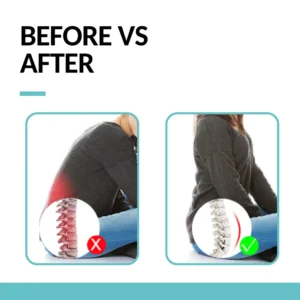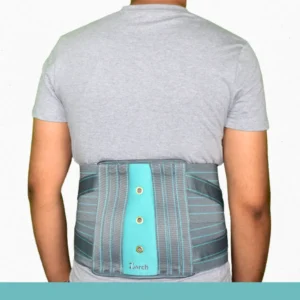Currently Empty: ₹0.00

How to Use a Lumbar Support Belt for Lower Back Pain Relief
Lower back discomfort can significantly affect daily life. A well‑designed lumbar support—like the Lumbo Sacral Belts you’re featuring—can make a huge difference. In this guide, we’ll explore how a lumbar support belt works, why it helps with lower back pain relief, and how to choose and use one correctly.
What Is a Lumbar Support Belt?
A lumbar support belt is an orthopaedic accessory designed to stabilize your lower back (lumbo‑sacral region). These belts are commonly used in workout routines, lifting activities, and by people suffering from chronic back issues. They relieve pressure on spinal structures and promote proper alignment.
Wearing lumbar support can not only reduce pain but also offer lower back pain relief during physical activities.
Who Needs Lumbar Support for Pain Relief?
Not everyone needs a lumbar belt—but if you fall into these categories, it can be beneficial:
- Desk professionals with sedentary posture
- Lifters or fitness enthusiasts needing extra core stability
- People recovering from minor lumbo sacral strain
- Those with mild chronic lower back pain
Before use, it’s wise to consult a doctor—especially if you’ve had surgery, sciatica, or disc issues. A brief Causes of Back Pain assessment (via your internal blog link) helps identify underlying conditions before relying solely on a support belt.
How Lumbar Support Belts Provide Lower Back Pain Relief
Improved Posture & Spinal Alignment
The belt gently applies pressure around the abdominal and lower back region. This encourages a straighter spine and corrects posture, which can reduce stress on spinal discs.
Spinal Stabilization
By supporting the muscles and fascia around the lumbar spine, the belt limits excessive movements that often aggravate injuries or pain.
Enhanced Proprioception
Wearing the belt increases body awareness, often prompting users to lift correctly and avoid awkward bending that can exacerbate lower back pain.
Pain Reduction via Compression
Gentle compression improves blood flow and reduces inflammation, so symptoms of muscle strain lessen more quickly.
This recent evidence indicates the efficacy of lumbar belts for lower back pain relief—especially when used alongside exercise and ergonomic adjustments.
Choosing the Right Lumbar Support Belt
When featuring Lumbo Sacral Belts on your e-commerce site, highlight:
- Adjustable Compression: Velcro or stretch panels that contour well
- Targeted Support: Reinforcements or stays across the lumbar region
- Comfort & Breathability: Lightweight, moisture-wicking fabric
- Appropriate Sizing: Belt should cover rib cage to pelvis without pinching
- Ease of Use: Simple to put on/off, particularly if mobility is limited
Recommend Products
Zorch: Lumbo Sacral Belt-Double Pull Plain
Zorch: Contour LS Support Belt – Double Pull (Woven)
Correctly Wearing a Lumbar Belt
Follow these steps for proper use:
Step |
Action |
Tip |
|
1 |
Loosen all straps |
This allows comfortable fit |
|
2 |
Place the belt low on your waist |
Align with your lumbar spine |
|
3 |
Secure primary straps snugly, not too tight |
You should feel support, not constriction |
|
4 |
Adjust auxiliary straps for extra compression |
Use only if required |
|
5 |
Check your movement |
You should be able to bend slightly and tighten after workouts |
Use the belt during workouts, lifting tasks, or when sitting long hours. Don’t depend on it all day—combine it with strengthening exercises for long-term relief.
Exercises to Do Alongside the Belt
To maximise benefits, pair your belt with these low-impact exercises:
- Pelvic Tilts: Strengthen core muscles
- Cat–Cow Stretch: Improves spinal flexibility
- Glute Bridges: Activates glute and core muscles
- Bird-Dog: Improves spinal and core stability
Regular activity ensures the lumbar belt supports rather than replaces muscle function.
How Long Should You Wear the Belt?
Best practice suggests
- During activity only – e.g., lifting, workouts, workdays
- For several hours at a time, not 24/7
- Maximum daily use: 6–8 hours
- Weekly limit: Worn 5–6 days, ideally.
On rest days or when sedentary (e.g., watching TV), skip the belt and practice posture awareness.
Common Mistakes & How to Avoid Them
- Over-tightening—leads to restricted breathing and core weakness
- Wearing on bare skin only—can cause chafing. Always over a thin T‑shirt
- Not exercising—relying solely on the belt weakens supporting muscles
- Ignoring red flags—stabbing, radiating pain or numbness? Stop belt use and consult a doctor immediately
When Not to Use a Lumbar Belt
Avoid lumbar belts if:
- You’ve had major spinal surgery or unstable fractures
- You suffer from severe disc herniation, sciatica with nerve involvement
- You’re pregnant ( Don’t use without medical guidance)
- You experience sharp radiating pain or sudden weakness
In such cases, consult an orthopaedic specialist before using any belt.
FAQs About Lumbar Support
How tight should a lumbar support belt be?
Snug enough to feel support, but loose enough to breathe normally. You shouldn’t feel pinching.
Can I sleep with a lumbar belt?
No—wearing it during sleep may hurt circulation and weaken muscles.
How often should I wear it?
Use it during activity for up to 8 hours daily and no more than six days a week.
Will I get dependent on it?
Risk of dependency exists if you stop exercising core muscles, so maintain your workout routine.
Can children or teens wear it?
Only use lumbar belts for minors under doctor guidance, especially if growth plates or spine development are a concern.
Final Thoughts
Lower back pain doesn’t have to disrupt your daily routine. With the right lumbar support belt, you can regain control, reduce discomfort, and enhance your mobility. Whether you’re recovering from an injury, managing posture at work, or simply looking for additional support during physical activity, a lumbo sacral belt can provide much-needed lower back pain relief.
Remember, consistency is key. Use the belt correctly, combine it with gentle exercises.








